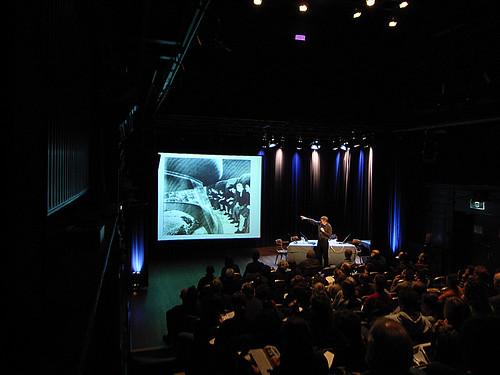The Diorama Revisited: Erkki Huhtamo at Sonic Acts
Erkki Huhtamo’s recent work deals with media archeology, an emerging approach he, according to his website, ‘has pioneered (together with others, like Siegfried Zielinski) since the early 1990’s’. At this edition of Sonic Acts, Huhtamo, together with the audience, revisited the concept of the Diorama. The keynote proved to be a valuable trip down memory lane with Huhtamo showing many examples and elaborating on their cultural context.
The Diorama was invented by Jacques Louis Mande Daguerre and Charles Marie Bouton and consisted of fast paintings, which were ‘slightly larger than an iMac screen’. Moreover, paintings were made in such a way that parts were translucent. In the early days, these diorama’s had to be visited and therefore it became a new element of urban landscape. Huhtamo mentions the Paris Diorama in this regard.

But why would the diorama be interesting for us, now, Huhtamo asks himself. Bruce Sterling mentioned the concept of “dead media”, Huhtamo however does not believe media is capable of dying: ‘I believe that it is more a transformation and adaptation. My research deals with understanding the materiality, discursive manifestations and how these layers coexist in culture, as the culture changes and evolves’. One of Huhtamo’s big inspirations to venture into the realm of media archeology, is the fact that artists sometimes seem to be aware of the traditions, go back to these ideas and draw inspiration from them.
In its purely mechanical form, The Diorama is a large viewing machine, an actorless optical illusion theatre, comprised of two main features, being firstly giant translucent and transforming paintings and secondly a mechnically rotating auditorium. Culturally the Diorama provided the world with a new word, a neologism, that many of these new spectacles had. The Diorama is no different, combining “dio” (transparent/through) and “rama” (view). Because it is actorless, Huhtamo sees a valuable connection between the rise of CGI possibilities and the Diorama: ‘Actors are more in the scenery’.
“rama-mania”
Continuing on the linguistics of the Diorama, Huhtamo mentions Balzac, who picked up a linguistic pattern from the hair salons and the cafes of Paris. Balzac provided his own list of “ramas”, including health-o-rama, frozenrama, soupe-au-rama and the goriorama. Images shown by Huhtamo of various Diorama’s and Daguerre’s paintings are available at R. D. Wood’s MIDLEY essays on the History of early Photography. An interesting development is the portable diorama, like the “desktop” version of the computer, the ‘huge and gigantic’ is eventually brought to the desktop.

Now, Huhtamo continues, ‘we are in the beginning of this dioramic transformation I’m trying to sketch’. Most important for this transformation is that ‘reality is not conceived as given, but as a construct. Reality as a product of new spectacles such as the diorama, panorama, wax museums, paris morgue, etc. This is the culture from which the diorama appears. In turn, Diorama’s themselves start to appear in painting’.
New Spaces and Urban Mobility
The Diorama in an urban context is ‘not like a home, but also not like the city screen outside. It is a place for the flaneur and movement in new spectacles’. Huhtamo mentions various examples of these flaneur-like places, such as the cosmorama. All share that they are about a mobile mode of spectatorship. Huhtamo: ‘The only way of viewing the panorama is to keep on walking / moving. Being physically in motion was taken over by cinema, however, the motion becomes virtual.
The audience is virtually moving with the scenes seen in the cinema’. Huhtamo sees a return to physical movement in the advent of portable devices. Interesting in the mixture of Diorama and movement is also the the idea of the “trottoir roulant”, the moving walkway, which was presented as a novelty in that time at the Paris world fair.It turned Paris into panoramic scene, the platform is enough to define the surroundings and change the identity of the surroundings
The Diorama even shaped its own popstar. Albert Smith travelled around with the moving diorama. His “hit” was ‘The Ascent of Mont Blanc’ which was shown an astonishing 2000 times. Objects used to create a reality effect include dogs and a Swiss chalet. In later years, various people played with the idea of the diorama. Examples of these include the 1939 Futurama by General Motors, which exhibited GM’s utopian vision of the world with streamlined buildings and, of course, as Huhtamo mentions, GM cars. In the futurama, the audience is traveling through the show. It is not static, like the diorama by Daguerre. The Diorama has been revisited.
Links
Report by Twan Eikelenboom – newmw.wordpress.com
Photography by – flickr.com/photos/shutenochdown